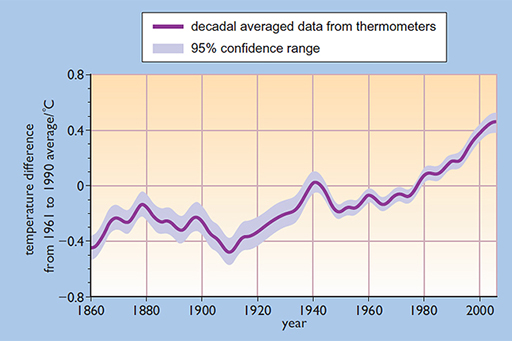5.1 What are the causes of climate change?
The surface temperature of the Earth establishes itself at an equilibrium level where the incoming radiative power energy from the Sun balances the outgoing reflected amd re-radiated power from the atmosphere and surface, as we will discuss in more detail later in the course.
If the Earth had no atmosphere, its surface temperature would be minus 18 °C, but its atmosphere includes ‘greenhouse gases’. These gases absorb some of the re-radiated infra-red energy, causing the Earth’s mean surface temperature to rise to about 15 °C – suitable for the wide variety of life forms that we have on our planet.
Activity 4
What are principal greenhouse gases?
Answer
They are:
- water vapour
- carbon dioxide
- methane.
These act like the panes of a greenhouse, allowing solar radiation to enter, but inhibiting the outflow of long-wave infrared heat radiation.
Since the Industrial Revolution human activities have been adding extra greenhouse gases to the atmosphere, with the principal contributor being carbon dioxide (CO2) from the combustion of fossil fuels.
So, what will happen if this continues?
Climate scientists estimate (IPCC, 2007a) that these human-induced emissions caused a rise in the Earth’s global mean surface temperature of approximately 0.7 °C between 1950 and 2005 (Figure 10). If emissions are not curbed they estimate that the temperature is likely to rise by between 1.4 and 5.8 °C by the end of the twenty-first century.
Such rises would increase the frequency of climatic extremes – floods or droughts – causing serious disruptions to agriculture and natural ecosystems. Thermal expansion of the world’s oceans could also mean that sea levels would rise by around 0.5 m by the end of the century, inundating some low-lying areas. And beyond 2100, or perhaps before, much greater sea level rises could occur if major Antarctic ice sheets were to melt (Independent, 2017).

The threat of these global climate changes is one of the main reasons why there is a growing consensus on the need to reduce greenhouse gas emissions.
So what should we do to reduce emissions?
Climate change experts advise that global mean temperature rises by 2050 should not exceed 2°C above pre-industrial levels, and that to achieve this global carbon emissions will need to be reduced by approximately 80%.
This implies that global CO2 emissions need to peak almost immediately and then fall sharply over the course of the rest of this century (Allen et al., 2009). Emission reductions on this scale will inevitably involve a switch to low- or zero-carbon energy sources such as renewables.
